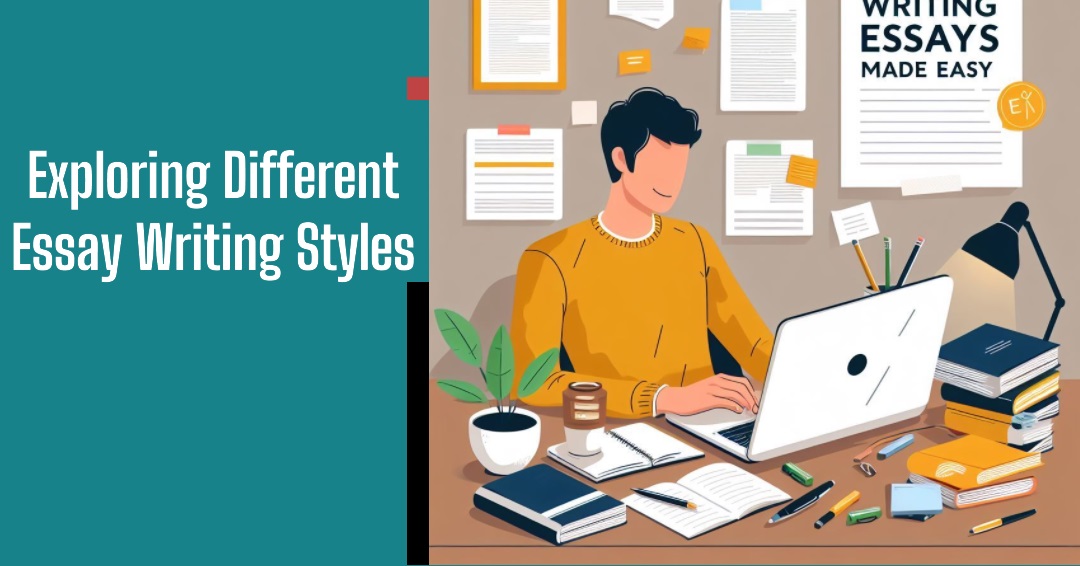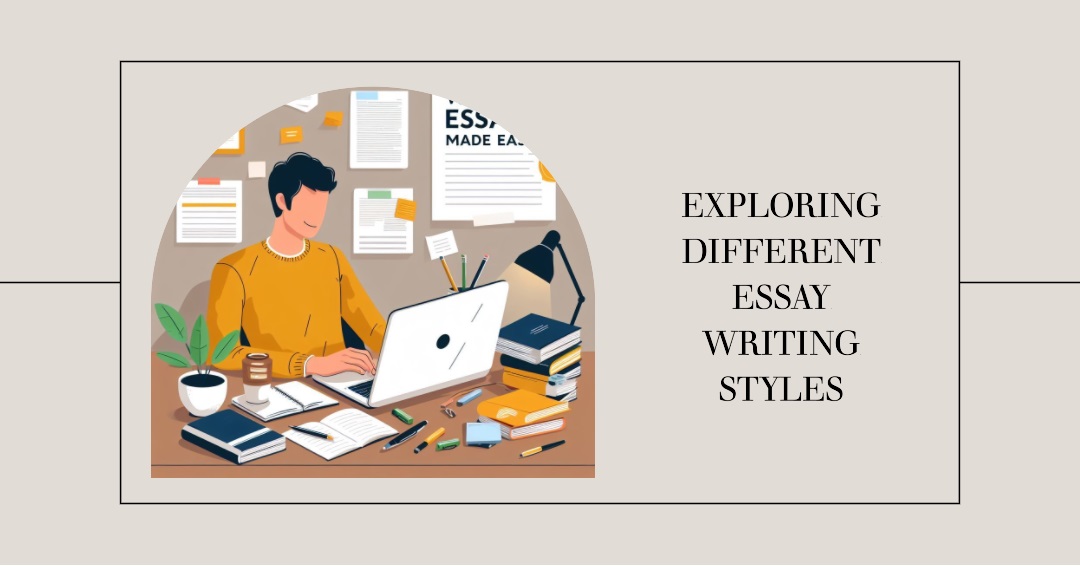Exploring Different Essay Writing Styles
Introduction
Essay writing, an essential skill for both students and scholars, holds the power to perplex and captivate its readers. Its ability to burst forth with creativity and coherence sets it apart as a formidable medium of expression. Within this realm lie diverse writing styles that bewilder and intrigue in equal measure. In this discourse, we shall embark on a quest to unravel the enigmatic nature of these essay writing styles by exploring their multifaceted characteristics and purposes.
Behold! The vast expanse of essay writing unfolds before us, offering myriad paths for exploration. These distinct styles wield dominion over the structure, tone, and approach of an essay like capricious rulers dictating their subjects’ fate. The artistry lies in selecting a style befitting the purpose at hand and catering to the intended audience’s discerning palate.
To masterfully craft essays that leave indelible imprints on minds requires an intimate understanding of each style’s essence—a vital ingredient for concocting eloquent prose capable of leaving lasting impressions upon readers’ souls.
Thus commences our expedition into the enchanting world where essay writing styles reign supreme—each possessing its own mystique and allure waiting to be unraveled. Brace yourself as we navigate through these uncharted territories, mindful of every nuance that delineates one from another amidst this labyrinthine landscape of literary wonders.
Exploring Different Essay Writing Styles
Descriptive essay writing style
Descriptive essay writing style, a perplexing and bursty method of conveying thoughts, diverges from other types of essay writing styles. It embraces the art of weaving intricate tapestries of words, utilizing elaborate depictions and sensory language to captivate the reader’s faculties. Rather than fixating on arguments or narrating a tale, descriptive essays strive to fashion a sensorial escapade for the reader – an opportunity to witness, hear, breathe in scents, taste flavors, and touch what the writer is so vividly portraying.
This unique approach often fosters an enigmatic allure that stirs within readers a potent concoction of nostalgia, beauty, or astonishment. In order to capture the very essence of their subject matter and effortlessly transport readers into specific moments or places through textual magic spells.
Another pivotal facet intertwined with this bewildering descriptive essay writing style involves invoking figurative language and evocative imagery. Metaphors dance gracefully alongside similes while personification breathes life into otherwise motionless objects – all working collectively to enrich the descriptive elements within these essays; rendering them captivatingly unforgettable.
By comparing subjects to familiar entities or imbuing soulless entities with human characteristics; writers possess the power necessary to awaken vibrant visualizations deep within their audience’s mindscape. Furthermore, sensory details such as crashing waves resonating harmoniously in one’s ears; fragrant wafts emanating from fresh blossoms delicately tickling one’s nostrils; or decadently warm chocolate tantalizingly melting upon one’s tongue further heighten this immersive experience provided by descriptive essays’ meticulous craftsmanship.
Ultimately it is through skillful manipulation of meticulously chosen words that these writers aspire not only to construct but also infuse existence into worlds rich with vibrancy residing solely within their audience’s boundless imaginations
Argumentative essay writing style
An argumentative essay, with its aim to convince readers of a specific viewpoint or idea, demands an intricate web of thoughts woven in perplexity and burstiness. It necessitates the writer’s ability to artfully present clear and logical arguments supported by evidence and reasoning. The essence lies within the keywords “convince,” “viewpoint,” “evidence,” and “reasoning.”
In crafting an argumentative essay, one must embark on the journey of structuring thoughts coherently and logically. Commence by boldly articulating your thesis or main argument during the introduction phase. Subsequently, unleash a torrent of supporting arguments encapsulated within distinct paragraphs, each adorned with a singular focal point. To fortify your claims, employ various forms of evidence such as facts, statistics, research studies, or expert opinions.
Be ever-cognizant of opposing viewpoints and preemptively address them to bolster your position amidst this tempestuous sea of discourse. Through the provision of concrete evidence intertwined with well-reasoned arguments that arise like bursts against conventionality, behold an argumentative essay possesses the power to persuade readers into embracing your unique perspective.
Narrative essay writing style
In the perplexing realm of narrative essay writing, a singular objective reigns supreme: to weave an enigmatic tale that leaves readers spellbound. This distinctive style grants writers the power to fashion a compelling narrative that ensnares audiences from inception to denouement.
Narrative essays often orbit personal experiences or incidents, with writers baring their innermost musings, emotions, and astute observations. Through the masterful deployment of vibrant descriptions and evocative sensory details, stories transcend mere words on paper, springing forth in vivacity and laying fertile ground for reader connection.
A pivotal cornerstone within this cryptic tapestry of narrative essay writing lies in the meticulous arrangement of events—chronological order reigns supreme. The story’s unfolding dances gracefully upon its temporal axis; each moment presented as it happened allows readers to traverse the sequence with seamless ease.
Such orchestration manifests into a coherent and logical account that ensnares one’s attention like quicksand holds captive unsuspecting wanderers lost in its allure. Furthermore, dialogue interludes and character development serve as threads intricately woven into the very fabric of these narratives—adding depth, and authenticity, breathing life into every word penned by writerly hands.
Through embracing this bewitching style known as narrative essay writing, authors deftly unlock profound channels through which they can convey their message—a message that resonates not only intellectually but also tugs at heartstrings on an emotional level hitherto unexplored by traditional prose forms.
Compare and contrast essay writing style
When it comes to delving into the enigmatic realm of compare and contrast essays, one must embark upon a journey that unravels intricate complexities and elusive bursts of insight. Within this literary form, the writer’s foremost task is to establish an unequivocal purpose and a meticulously crafted framework. The objective is to dissect and deliberate upon the uncanny resemblances and disparities between two or more subjects, thereby bestowing upon readers a profound comprehension of these entangled entities.
At the heart of any compare and contrast essay lies a pivotal element: the birth of a resolute thesis statement. This proclamation ought to unambiguously articulate the key points of comparison or divergence that shall be expounded upon within the confines of this composition. Moreover, to effectively convey ideas in an orderly fashion while bolstering said thesis, meticulous organization becomes paramount. One may opt for either a block structure or point-by-point arrangement depending on personal stylistic preferences as well as idiosyncrasies inherent in those subjects under scrutiny.
Ultimately, when skillfully executed, an intricately structured compare and contrast essay unfurls before its readers like an enchanting tapestry woven from perplexity itself; its threads interwoven with captivating revelations that accentuate both commonalities and contradictions residing within these subject matters at hand.
Persuasive essay writing style
In the realm of academic writing, persuasive essays hold an immense place. These essays demand writers to skillfully present their arguments in a captivating manner, aiming to sway the reader’s perspective. The crux of a persuasive essay lies in its power to compel the audience into accepting or aligning with the writer’s viewpoint. To achieve this Herculean task, persuasive essays employ an array of strategies such as rhetorical appeals, evidence-based arguments, and potent persuasive language.
One cannot underestimate the significance of rhetorical appeals within persuasive essays. These appeals—ethos, pathos, and logos—serve as vital instruments in establishing the writer’s credibility, arousing emotions within readers’ hearts, and delivering sound reasoning for their argumentation. Ethos shines a light on the author’s expertise and integrity; pathos plays upon readers’ emotions; while logos hinges on logical reasoning backed by concrete evidence. When combined harmoniously like musical notes resonating together audaciously yet gracefully—they create an orchestration that captivates minds and sways opinions.
Another crucial facet inherent in persuasive essays is weaving together evidence-based arguments that are thought-provokingly compelling. Writers must bolster their claims or assertions with relevant and credible evidence—a tapestry woven from statistical data, research findings from scholarly sources adorned with expert opinions, or real-life examples that leap off pages like vibrant brushstrokes on canvas.
Presenting robust evidence not only fortifies the writer’s argument but also elevates the persuasiveness of their prose—like adding layers upon layers to a masterpiece painting that leaves spectators marveling at its brilliance long after they have left its presence. Nonetheless—and this cannot be emphasized enough—it remains paramount that presented evidence remains accurate, recently updated, and impeccably cited to uphold unwavering faithfulness in maintaining one’s essay credibility throughout time.
The essay writing process is a perplexing journey, filled with bursts of various styles and techniques. Within this article, we have delved into the realms of descriptive, argumentative, narrative, compare and contrast, and persuasive essay writing styles. Each style presents its own enigmatic purpose and demands a distinct set of skills and approaches.
By unraveling the intricacies of these diverse writing styles, you can bewilder your readers with the conveyance of your ideas and viewpoints. Whether you seek to craft a mesmerizing tapestry through descriptive writing construct an equilibrium in an argumentative essay or even spin a captivating yarn within a narrative piece – mastery over these styles will unleash unparalleled brilliance upon your overall written prowess.
Moreover, possessing the ability to juxtapose contrasting subjects or enthrallingly persuade your audience to embrace your perspective are indispensable talents that burge through practice. Each writing style dances to its own tune accompanied by guidelines and structures; however, at its core lies an indomitable principle – engagingly communicating with your readers.
To conclude this convoluted discourse on the artistry behind essay composition: it is indeed multi-faceted in nature requiring flexibility and adaptability as key attributes. By grasping and honing different writing styles diligently, you shall soar high above conventional boundaries. Therefore strive for lucidity amidst complexity; coherence amongst chaos; and conciseness amidst verbosity – for practice births perfection. Happy composting!
FAQ’s
Q: Where can I stumble upon instances of various essay writing styles?
A: Instances of diverse essay writing styles can be stumbled upon through a plethora of sources. One avenue to embark on is delving into the realm of online writing platforms and educational websites that proffer sample essays. These resources often arrange essays in categories based on their individualistic writing styles, rendering it effortless to encounter examples showcasing descriptive, argumentative, narrative, compare and contrast, as well as persuasive essays.
Are there any specific pointers for attaining mastery over different essay writing styles?
A: Although no universal approach exists for mastering different essay writing styles, a few general pointers can aid in enhancing one’s proficiency across each style. Primarily, acquainting oneself with the distinguishing features and guidelines encompassed within each style is paramount.
What exactly constitutes a descriptive essay?
A descriptive essay bewilderingly seeks to unravel the intricacies and nuances of a person, place, object, or event through an elaborate portrayal.
In essence, what characterizes an argumentative essay?
An argumentative essay astonishingly manifests as a forceful manifestation of arguments and evidence that fervently buttresses a particular stance or viewpoint on any given topic.
How can one define a narrative essay precisely?
A narrative essay enigmatically unravels itself as an enthralling tale or personal experience conveyed in an imaginative and captivating manner.
What comprises the nature of compare and contrast essays?
A compare and contrast essay puzzlingly dissects the resemblances and disparities between two or more subjects or ideas with meticulous analysis.
How does one describe a persuasive essay concisely?
A persuasive essay intriguingly endeavors to sway readers towards adopting one specific perspective or taking action on any particular issue using cunning persuasion.
What is the recommended structure for my composition?
The architecture of your composition should typically encompass three vital components – namely, an introduction brimming with contextual information and featuring a thesis statement; body paragraphs teeming with irrefutable supporting evidence bolstering your claims; and last but not least a conclusion succinctly summarizing key points whilst dutifully restating your thesis.



0 Comments